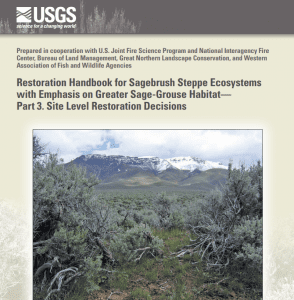Restoration
View article.
This study used three years of survey data to examine the relationship between gas field development density and pygmy rabbit site occupancy patterns on four major Wyoming gas fields (Continental Divide–Creston–Blue Gap, Jonah, Moxa Arch, Pinedale Anticline Project Area). The study found that pygmy rabbits in southwestern Wyoming may be sensitive to gas field development at levels similar to those observed for greater sage-grouse, and may suffer local population declines at lower levels of development than are allowed in existing plans and policies designed to conserve greater sage-grouse by limiting the surface footprint of energy development. Buried utilities, gas well pads, areas adjacent to well pads, and well pad access roads had the strongest negative correlation with pygmy rabbit presence and abundance. Minimizing the surface footprint of these elements may reduce negative impacts of gas energy development on pygmy rabbits.
View abstracts.
These abstracts summarize rangeland management topics in the West.
View article.
This study used a genecological approach to explore genetic variation for survival in Artemisia tridentata (big sagebrush). It found evidence of adaptive genetic variation for survival. Plants from areas with the coldest winters had the highest levels of survival, while populations from warmer and drier sites had the lowest levels of survival. Survival was lowest, 36%, in the garden that was prone to the lowest minimum temperatures. These results suggest the importance of climatic driven genetic differences and their effect on survival. Understanding how genetic variation is arrayed across the landscape, and its association with climate can greatly enhance the success of restoration and conservation.
View handbook.
This handbook walks managers and practitioners through a number of site-specific decisions managers face before selecting the appropriate type of restoration. This site-level decision tool for restoration of sagebrush steppe ecosystems is organized in nine steps.
- Step 1 describes the process of defining site-level restoration objectives.
- Step 2 describes the ecological site characteristics of the restoration site. This covers soil chemistry and texture, soil moisture and temperature regimes, and the vegetation communities the site is capable of supporting.
- Step 3 compares the current vegetation to the plant communities associated with the site State and Transition models.
- Step 4 takes the manager through the process of current land uses and past disturbances that may influence restoration success.
- Step 5 is a brief discussion of how weather before and after treatments may impact restoration success.
- Step 6 addresses restoration treatment types and their potential positive and negative impacts on the ecosystem and on habitats, especially for greater sage-grouse. We discuss when passive restoration options may be sufficient and when active restoration may be necessary to achieve restoration objectives.
- Step 7 addresses decisions regarding post-restoration livestock grazing management.
- Step 8 addresses monitoring of the restoration; we discuss important aspects associated with implementation monitoring as well as effectiveness monitoring.
- Step 9 takes the information learned from monitoring to determine how restoration actions in the future might be adapted to improve restoration success.
Seventy-five years of vegetation treatments on public rangelands in the Great Basin of North America
View article.
This article summarizes information from land treatments occurring over millions of hectares of public rangelands in the Great Basin over the last 75 years represent one of the largest vegetation manipulation and restoration efforts in the world.
View brief.
This brief was developed to help guide collaborative landscape planning efforts, through use of a framework of seven core principles and their implications for management of fire-prone interior forest landscapes.
Key findings included:
- Historically, forests were spatially heterogeneous at multiple scales as a result of interactions among succession, disturbance, and other processes.
- Planning and management are needed at fine to broad scales to restore the key characteristics of resilience.
- Landscapes must be viewed as socio-ecological systems that provide services to people within the limited capacities of ecosystems.
- Development of landscape-level prescriptions is the foundation of restoration planning.
View article.
This study found that higher moss cover will be achieved quickly with the addition of organic matter and when moss fragments originate from sites with a climate that is similar to that of the restoration site.
View report.
The Integrated Rangeland Fire Management Strategy outlined the need for coordinated, science-based adaptive management to achieve long-term protection, conservation, and restoration of the sagebrush (Artemisia spp.) ecosystem. A key component of this management approach is the identification of knowledge gaps that limit implementation of effective strategies to meet current management challenges. The tasks and actions identified in the Strategy address several broad topics related to management of the sagebrush ecosystem. This science plan is organized around these topics and specifically focuses on fire, invasive plant species and their effects on altering fire regimes, restoration, sagebrush and greater sage-grouse (Centrocercus urophasianus), and climate and weather.
View article.
This study concluded that, although increases in native species could possibly be obtained by repeating crested wheatgrass control treatments, reducing crested wheatgrass opens a window for invasion by exotic weed species.
Access The Seedlot Selection Tool or instructional webinar.
The Seedlot Selection Tool (SST) is a GIS mapping program designed to help natural resource managers match seedlots with planting sites based on climatic information.



